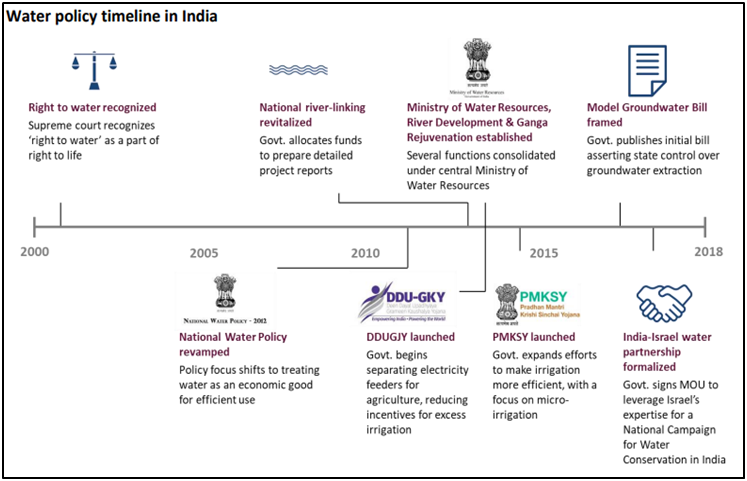Composite Water Management Index (CWMI)
06-11-2023
03:58 PM
1 min read

What’s in Today’s Article?
- Why in News?
- Background in which the Composite Water Management Index (CWMI) Launched
- What is the CWMI?
- News Summary Regarding NITI Aayog’s Decision to Make CWMI ‘Internal’

Why in News?
- NITI Aayog is learnt to have marked the reports on states progress on water management for 2018-19 and 2019-20 for “internal use” after having publicly released the previous editions.
- Called the ‘Composite Water Management Index’ report, the first edition launched five years ago in June 2018 brought India’s water challenges into spotlight and ranked states in terms of efficacy based on 28 parameters.
Background in which the Composite Water Management Index (CWMI) Launched
- India is suffering from the worst water crisis in its history and millions of lives and livelihoods are under threat.
- Currently, 600 million Indians face high to extreme water stress and about two lakh people die every year due to inadequate access to safe water. The crisis is only going to get worse.
- By 2030, the country’s water demand is projected to be twice the available supply, implying severe water scarcity for hundreds of millions of people and an eventual ~6% loss in the country’s GDP.
- As per the norms, the availability value of less than 1,700 cubic meter/person/year indicates water shortage.
- Water availability below 1,000 cubic metre/capita/year is considered as “scarcity”.
- The UN University - Institute for Environment and Human Security (UNU-EHS), had warned that India is close to reaching its groundwater risk tipping point.
- Environmental tipping points are critical thresholds in the Earth’s systems, beyond which abrupt and often irreversible changes occur.
- Thus, there is an imminent need to deepen the understanding of India’s water resources and usage and put in place interventions that make its water use efficient and sustainable.
What is the CWMI?
- About:
- The National Institute for Transforming India (NITI) Aayog has developed the CWMI in 2018 to enable effective water management in Indian states in the face of this growing crisis.
- The report is being prepared in association with 3 ministries - Water Resources, Drinking Water & Sanitation, and Rural Development.
- Objectives of the Index:
- To bring about much-required improvements in water resource management and conservation in India in a coherent and collaborative manner.
- It will be a public platform that provides an annual snapshot of the water sector status and the water management performance of the different states and UTs in India.
- It will measure both the overall progress made by states in water management and the incremental improvement in performance across time.
- Significance of the Index:
- It is meant to foster a culture of evidence and data-backed policy-decisions for sustainable and efficient management of water resources.
- The Index is expected to promote the spirit of 'competitive and cooperative federalism' in the country.
- The data included in the Index will be made publicly available to researchers and entrepreneurs to drive innovation in the sector.
- The collection and compilation of this strategic dataset is a big step towards addressing the country’s projected water risk and shortfall.
- Themes and indicators of the Index: The Index comprises 9 themes (each having an attached weight) with 28 different indicators covering -
- Groundwater and surface water restoration,
- Major and medium irrigation,
- Watershed development,
- Participatory irrigation management,
- On-farm water use,
- Rural and urban water supply, and
- Policy and governance.
News Summary Regarding NITI Aayog’s Decision to Make CWMI ‘Internal’
- The first edition of the CWMI provided data for 2015-16 and 2016-17, and the second edition launched in August 2019 was for 2017-18.
- According to the report for 2019-20, Gujarat tops the list with continuous improvements year on year and is closely followed by Rajasthan, Andhra Pradesh and MP in terms of performance.
- Recently, the NITI Aayog wrote to the Union Ministry of Jal Shakti, seeking the government’s perspective on the “use and applicability” of the Index and whether the CWMI should continue.
- There has been no response from the Ministry, even as the third and fourth editions are awaiting release.
- The latest report maps the performance of states for 2018-19 and 2019-20, and points out that water scarcity is a “national problem”.
- The average annual per capita water availability is expected to reduce to 1,486 cubic meters per person per year by 2021 from 1,545 cubic meters per person per year in 2011.
Q1) What is the Atal Bhujal Yojana?
Launched on 25 December 2019, the purpose of Atal Bhujal Yojana is to improve groundwater management in 7 states (Gujarat, Haryana, Karnataka, MP, Maharashtra, Rajasthan, and UP) of India.
Q2) What is the Pradhan Mantri Krishi Sinchayee Yojana (PMKSY)?
Launched in 2015, PMKSY aims to enhance access to water for farming, expand cultivable area under assured irrigation, improve water use efficiency, and promote sustainable water conservation practices.
Source: NITI weighs discontinuing key water report launched 5 years ago


